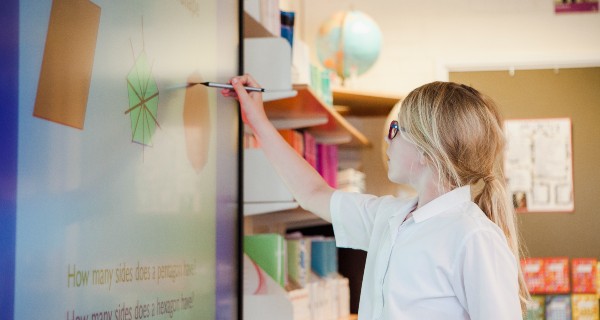by Frances Johnston, Curriculum Leader for Maths in the Junior School
Can you remember Maths lessons when you were at school? My own personal memories are of some individual struggle. At ESMS Junior School, I am pleased to say that our approach to teaching maths could not be more different!
Several years ago in the Junior School, we pledged to make our Mathematics teaching more active and engaging, while maintaining a good balance of traditional methodology. Children are still expected to rote-learn number bonds and times tables, but mathematics is not an abstract concept. In our classrooms, we rely less on textbooks, focusing instead on active, collaborative problem-solving and applying clearly written methodology.
Lessons start with a fun warm-up to charge our brains and get us thinking and communicating. The main part of the lesson is then taught in an interactive way, with the teacher encouraging all children to be engaged and active, using a range of tools from individual whiteboards to digital devices.
I am a huge advocate of “Active Maths” because it requires children to interact with concepts, rather than being told; and of course, when children are actively engaged, they develop a deeper understanding. The approach itself is quite simple. At the early stages of learning a new concept, children investigate with concrete materials, for example ordering number stones, grouping counters or building a model. Children are then asked to visualise the problem, which could include creating drawings and symbols to represent shapes and numbers. Once they have fully grasped the concept, we then ask the children to apply their new knowledge and skills using abstract symbols, such as numbers and +, – and x signs. This is when standard written methods are taught.
Whatever career path your child follows, from Apple to Accenture to Amazon, most employers now expect people to be able to problem-solve together in teams, so children need to learn these important skills while they are at school. That is why we encourage our children to work with partners or small groups by communicating, building knowledge and testing ideas. Not only do they really enjoy working in this way, but it also helps them to become far more engaged in the art of problem-solving.
Of course, children learn best when they are having fun and, in the Junior School, we love finding different ways to bring our Maths lessons to life. Digital technologies, including online platforms such as Times Tables Rockstars and Education City, are a major part of this, as is Outdoor Learning, where children take their lessons outside to apply Maths in the natural world. Music is also an important feature of the Maths class, with songs and raps used to help children to memorise patterns, facts, processes and vocabulary, just as they do when learning another language.
Despite my unsteady start to the learning of Maths, it is my favourite subject to teach. I feel privileged to be a part of building children’s mathematical enthusiasm and confidence and I hope that my legacy will be a generation of children who are fluent in the language that is Maths.






